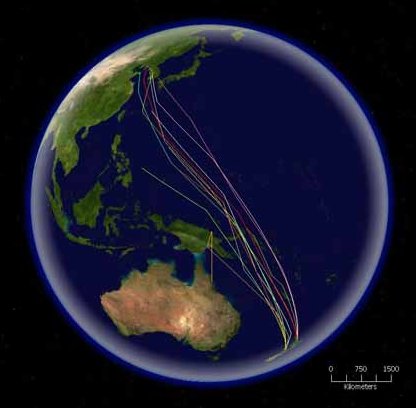
As I write this, I am at sea about 600 miles east of the Caribbean. Very few birds are in the middle of the ocean here except for the occasional shearwater. But yesterday we had some unusual avian visitors. First I saw a white egret circle the ship a few times. I wasn’t quite sure what it was and after a few circumnavigations of the ship, it disappeared. Turns out it landed on an upper deck of the ship to rest and another passenger took its photo and I was able to identify it as a Cattle Egret. We were at least 600 miles from land, so the bird had been flying for quite awhile. Cattle Egrets, native to Africa, made their way across to South America in the late 1800’s apparently in just this way – crossing the Atlantic on their own steam. Of course, they are now common in parts of North America.
The Fieldfare, a thrush native to Europe as well as eastern Asia and north Africa, breeds in southern Greenland. Apparently, in 1937, a flock of Fieldfares were blown off their migratory route and ended up in Greenland.
One might expect water-oriented birds to occasionally get lost at sea; I have seen herons, egrets, and kingfishers land on a ship to rest. Sometimes in the night a disoriented petrel or shearwater hits the ship and becomes temporarily unable to fly. I’ve also seen land birds such as sparrows and wagtails live on a ship from port to port, eating the insects attracted by the vessel’s lights. But this cruise gave me the most unusual sighting of all.
While watching the egret circle the ship, I saw a large dark bird fly past the starboard side of the ship. My initial glimpse of it only gave me the impression of a large, dark bird, but not a seabird. Then it flew forward on the port side and across the deck of the ship. My second impression was that of an owl, but I thought that was unlikely. My third look at it, however, convinced me that it was an owl. Turns out that the passenger who photographed the heron also got pictures of the owl, not great ones, but good enough for me to identify it as a Long-eared Owl. Later I found it spent the night on the top deck of the ship before it left.
How and why these two birds found our ship in the middle of the Atlantic is beyond me. They somehow became lost or blown off course and the ship was the only solid object for many miles. There is no question that many birds, either individually or in flocks, fly over or near the ocean and for some reason find themselves far from land. I suspect many of them perish. But some migrants are made for such a journey. The Bar-tailed Godwit breeds in Alaska and flies non-stop for 5-7days from western Alaska across the Pacific Ocean, nearly 7000 miles, to winter in New Zealand and Australia. Evolution has allowed these shorebirds to adapt to such a journey.

Fate has dealt this egret and owl a different hand.
Roger, I really like your “story telling” style and, as always, this post was interesting and informative.
Have you ever been to Australia where we have an estimated 357 endemic bird species, more than 99% of the rest of the world?
In fact, I am very privileged to live in the picturesque, highlands (850 metres) town of Tenterfield where 250 bird species have been sighted within 10 kilometres of our retirement cottage. And where the local record for bird species sightings stands at 115.
If you are ever in Australia, I suggest you come visit and I will be honoured to show you around.
All the best,
Pete Murphy,
Birdwatcher